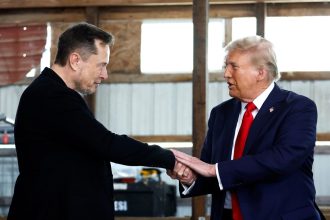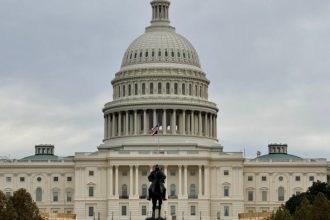Perched in a former leather workshop overlooking the Jialing River in China’s mountainous western metropolis of Chongqing, the Flying Tigers Museum retells what is still a high point in US-China relations.
Here the story of the US and Chinese pilots who together defended China’s Nationalist government against the Japanese during the second world war is commemorated through exhibits of their flight jackets and portraits of their P-40 fighters, with distinctive shark grin livery.
“This museum shows that united we can achieve much more,” said Richard, a tourist from Shandong province who only wanted to be identified by one name, of the lessons of the episode for US-China relations.
It is a message being pushed by Beijing’s propagandists as they prepare for an expected meeting on Wednesday between China’s President Xi Jinping and his US counterpart Joe Biden on the sidelines of the Asia-Pacific Economic Cooperation forum in San Francisco.
After years of portraying the US as a hegemon in terminal decline — especially during the coronavirus pandemic, when bilateral relations plumbed new lows — China’s state media has recently revived the story of the “spirit of the Flying Tigers” to set the tone for reviving dialogue with Washington.
“China-US relations need ‘a new generation of Flying Tigers’,” Xi said in a letter in September to former US pilots Harry Moyer and Mel McMullen, survivors of the volunteer force that helped defend Chongqing, the former Nationalist government’s wartime capital.

Analysts, however, said the warmer message did not signal a change in the Communist party’s long-running narrative of China’s inevitable rise and the US’s decline.
“There is that tension there — below this talk of people-to-people relationships, the Flying Tigers . . . this other propaganda still continues,” said David Bandurski, director of the China Media Project research group. “In fact, this whole worldview is built around a core of: ‘We are not America’.”
Xi has long asserted that the US is in decline, repeating the slogan “dong sheng, xi jiang” — the “east rises, the west falls”.
China stepped up this campaign as tensions rose in recent years over technology and trade, claiming that its authoritarian model was a more effective alternative for the developing world, analysts said.
It has underlined that case with an endless stream of conventional and social media coverage of bad news from the US, with extensive reporting of high school shootings, banking sector woes and February’s derailment of a train carrying toxic materials in Ohio.
The purpose was to “undermine the general credibility of the United States as an aspirational place”, Bandurski said, and to counter any notion that “its governance is capable, that it’s really democratic or that its press is free”.
Even as the US and China have resumed high-level dialogue in recent months, state news agency Xinhua has published reports such as “Experts say US military hegemony wrecks peace, violates human rights”, and “California’s young workers face low wages, long working hours, bleak future”.
The message is “Uncle Sam is the big bad villain and China is the force for good,” said Moritz Rudolf, a fellow at Yale Law School’s Paul Tsai China Center.
Critics complain that the western media also conveys a disproportionately negative image of China. But western governments’ influence is far more limited than that of Beijing’s state censors, who provide daily guidance on what to publish, shut down outlets that do not listen and jail those deemed to have gone too far.
Manoj Kewalramani, author of a newsletter that tracks the Communist party’s flagship People’s Daily newspaper, said its portrayal of the US was an indicator of the health of the bilateral relationship.
“Over the last five to seven years it has progressively gotten worse,” he said. “The essential argument is that American foreign policy is not about values or freedom or any of that, it is fundamentally about containment.”
Kewalramani added that the main official outlets such as the People’s Daily still set the agenda for think-tanks, academics and social media commentators.
The party’s messaging is reflected in viral memes on popular Chinese social media platforms. One recent post on microblogging platform Weibo depicted the G7 countries as 19th-century colonialists. Another featured a panda that returned to China this year from Memphis Zoo, where there was controversy over her treatment. “She was discriminated against because she was Asian,” it said.

There was evidence these campaigns were effective, experts said. Most young people have only had access to an internet ringfenced by China’s “great firewall”, which blocks sites outside its borders. They also tend to be among the most faithful to the party line.
“It is almost like their minds have been armed so that when they jump over [the firewall] they are patriotic defenders,” said Sean Haines, a Briton who worked for Xinhua and China Daily as a scriptwriter and then commentator from 2016 to 2018.
Yet since China’s Covid debacle last year, when Beijing imposed economically ruinous lockdowns before abruptly abandoning the policy, there are signs some young people are changing their minds despite the propaganda.
“Most students that I get in touch with, their level of unhappiness with China is greater than their level of unhappiness with the US,” said one education consultant.
Perhaps because of the weaker-than-expected economic recovery, China has begun taking steps in recent months to repair relations with the US, analysts said — which is where the Flying Tigers have come in.
Washington has played along, with US ambassador Nicholas Burns last month hosting McMullen and Moyer, the two former Flying Tigers, at a ceremony in Beijing.
“The governments may be different. But the people actually always have one desire and that is to live and to raise their families in peace,” said McMullen, recounting how Chinese villagers had saved his comrades who were shot down during the war.
Scholars question, however, whether such symbolic gestures or the Xi-Biden talks will have much effect on China’s domestic messaging on the US.
“The dynamic of their competitive relationship is structurally ordained,” said Zhang Baohui, professor of political science at Lingnan University in Hong Kong.
The relatively empty halls of the Flying Tigers Museum demonstrated how much still needed to be done to restore good relations.
There used to be “busloads and busloads of tourists”, said the museum’s caretaker estimating up to 70,000 foreign visitors a year before Covid. “Now there are only 10-20 per month.”
Read the full article here




